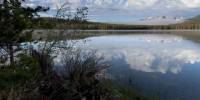© 2005 Jim Liesenfeld, All Rights Reserved.
The Sawtooth-Stanley country was first seen by whites when a party of John Jacob Astor's fur trappers under Alexander Ross explored it in 1824. They were impressed by the beauty of the country and the abundance of game, including the salmon. The Salmon River, which winds through Idaho to the Snake River is an ancient spawning ground for the saltwater Steelhead trout and Chinook and Sockeye salmon. This fresh water spawning ground on the Salmon River is an amazing 800 miles from the Pacific Ocean.
Today, 200 years after salmon helped keep the Lewis & Clark Expedition from starving in late 1804, 12 species of Columbia and Snake River salmon are listed under the Endangered Species Act as either threatened or endangered. The predominant cause has been construction of over two hundred dams on the Columbia, Snake and its tributaries. The particular villains are the large federal dams on the main Snake and Columbia Rivers. All remaining Snake River salmon and steelhead (ocean-migrating rainbow trout) species are endangered. The dams on the main Columbia were needed to power aluminum production during WWII, but between 1962 and 1975 four additional and superfluous dams were built on the lower Snake River to allow the barging of grain and wood products from Lewiston, ID to Portland, OR. Those four federal dams in southeast Washington were the ones to break the backs of the salmon runs, especially those to and from Idaho.



 Tap or click the zoom icon in the bottom right corner of the picture to switch between in-page and fullscreen view
Tap or click the zoom icon in the bottom right corner of the picture to switch between in-page and fullscreen view